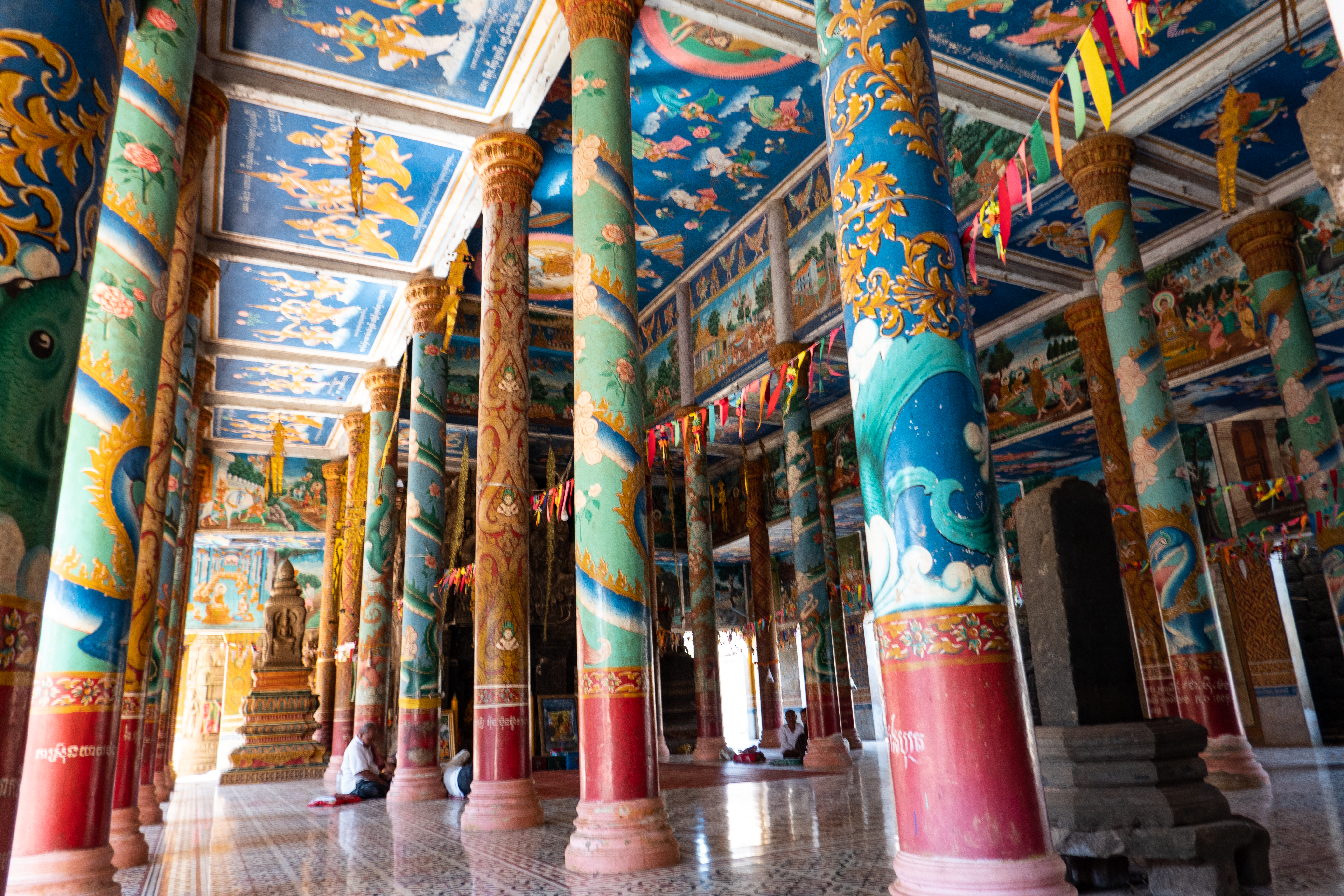|
Roluos (temples)
Roluos ( Khmer: រលួស) is a Cambodian archeological site about 13 km east of Siem Reap along NH6. Once it was the seat of Hariharalaya, first capital of Khmer Empire north of Tonlé Sap (as the first capital in the strict sense of the term could have been Indrapura, identifiable with Banteay Prey Nokor). Among the "Roluos Group" of temples there are some of the earliest permanent structures built by Khmer. They mark the beginning of classical period of Khmer civilization, dating from the late 9th century. Some were totally built with bricks, others partially with laterite or sandstone (the first large Angkorian temple built with sandstone was possibly Ta Keo Freeman, Jacques 2006, p.26) At present it is composed by three major temples: Bakong, Lolei, and Preah Ko, along with the smaller Prasat Prei Monti. At both Bakong and Lolei there are contemporary Theravada buddhist monasteries. There is a town named Roluos also Phumi Roluos Chas, which is a khum Admini ... [...More Info...] [...Related Items...] OR: [Wikipedia] [Google] [Baidu] |
Hariharalaya
Hariharalaya ( km, ហរិហរាល័យ, Hariharalay) was an ancient city and capital of the Khmer empire located near Siem Reap, Cambodia in an area now called Roluos ( Khmer: រលួស). Today, all that remains of the city are the ruins of several royal temples: Preah Ko, the Bakong, Lolei.Higham, C., 2001, The Civilization of Angkor, London: Weidenfeld & Nicolson, Higham, C., 2014, Early Mainland Southeast Asia, Bangkok: River Books Co., Ltd., Etymology The name "Hariharalaya" is derived from the name of Harihara, a Hindu deity prominent in pre-Angkorian Cambodia. The name "Harihara" in turn is a composite of "Hari" (one of Vishnu's names listed in Vishnu sahasranama) and "Hara" (meaning the Hindu god Shiva). Cambodian representations of Harihara were of a male deity whose one side bore the attributes of Vishnu and whose other side bore the attributes of Shiva. For example, the deity’s head-covering consisted of a mitre-type hat (the attribute of Vishnu) on o ... [...More Info...] [...Related Items...] OR: [Wikipedia] [Google] [Baidu] |
Banteay Prey Nokor
Banteay Prei Nokor ( km, បន្ទាយព្រៃនគរ) is an ancient temple complex in the northwest of Kompong Cham, Cambodia. Known locally as temple of "Wat Nokor in Khum of Kompong Siem", or "Wat Angkor", around 2km from the provincial capital Kampong Cham (city). though a sign at the entrance now officially designates the name of the temple as Nokor Bachey Temple ( km, ប្រាសាទនគរបាជ័យ). Layout The complex faces east at a bearing of 84.5°E, and covers 15ha. the site is composed of an outer rectangular laterite wall approximately 420x370m, an inner wall approximately 100x130m. A large reservoir or Baray ( km, បារាយណ៍) some 950 meters long and 480 meters wide is located 350 meters east of the site. Now abandoned, the reservoir area was used in the mid 20th century as a hippodrome, evidence of which can still be seen by visitors. History The monument was built out of sandstone and laterite, and dates from t ... [...More Info...] [...Related Items...] OR: [Wikipedia] [Google] [Baidu] |
Populated Places In Siem Reap Province
Population typically refers to the number of people in a single area, whether it be a city or town, region, country, continent, or the world. Governments typically quantify the size of the resident population within their jurisdiction using a census, a process of collecting, analysing, compiling, and publishing data regarding a population. Perspectives of various disciplines Social sciences In sociology and population geography, population refers to a group of human beings with some predefined criterion in common, such as location, race, ethnicity, nationality, or religion. Demography is a social science which entails the statistical study of populations. Ecology In ecology, a population is a group of organisms of the same species who inhabit the same particular geographical area and are capable of interbreeding. The area of a sexual population is the area where inter-breeding is possible between any pair within the area and more probable than cross-breeding with ind ... [...More Info...] [...Related Items...] OR: [Wikipedia] [Google] [Baidu] |
Khum
Administrative divisions of Cambodia have several levels. Cambodia is divided into 24 provinces (''Khaet''; km, ខេត្ត, ) and the special administrative unit Phnom Penh. Though a different administrative unit, Phnom Penh is at province level, so ''de facto'' Cambodia has 25 provinces and municipalities. Each province is divided into districts (''Srok''/''Khan''; , /) - there are 159 districts throughout the country’s provinces, and 12 are in Phnom Penh. Each province has one capital district (changed to " city/town", ''krong''; , ), e.g. for Siem Reap, it's ''Srok Siem Reap''. The exceptions are the provinces of Banteay Meanchey, Kandal, Mondulkiri, Oddar Meanchey, Preah Vihear and Ratanakiri, where the province and the capital district does not match. A district of a province, which is called ''Srok'' (, ), is divided into "communes" (''khum''; , ). A commune is further divided into "villages" (, ). In Phnom Penh the districts are called ''khan'' (, ), and ... [...More Info...] [...Related Items...] OR: [Wikipedia] [Google] [Baidu] |


